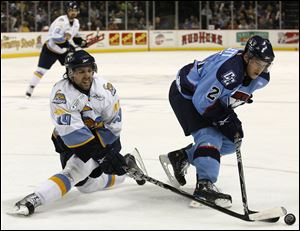
Checkers made good move
But Charlotte franchise's jump to AHL wasn't an easy one
5/6/2012
The Walleye’s Sal Peralta, left, battles Charlotte’s Mike Bartlett in an ECHL game April 7, 2010, at the Huntington Center. The Checkers moved to the American Hockey League the next season.
After 17 seasons as an ECHL franchise, the Charlotte Checkers decided it was time to make the jump to the American Hockey League.
It wasn't as easy as simply shedding one league for another. It's a lengthy process to acquire an AHL franchise, because in a sense, each one is a commodity. With a 30-team cap, the chances of new ownership groups and new franchises to fill any vacancies are slim.
In Charlotte's case, the move to becoming the AHL affiliate of the Carolina Hurricanes was the product of a perfect storm. A team ownership vacancy became available, as Walter Robb announced his intention to sell the Albany River Rats in November of 2009, and a parent team within geographic reach became available, as the Hurricanes were in search of an AHL affiliate.
At the same time Checkers owner Michael Kahn was completing the purchase of Albany's AHL franchise in early 2010, he had to return the Checkers' rights to the ECHL because he could not find a buyer for the organization.
Terms of the purchase of the Albany franchise were not made public, but in October, 2010, the Charlotte Business Journal quoted industry experts who put the value of AHL teams between $2.5 million and $4.5 million.
The process of securing an AHL franchise is detail-oriented, which includes due diligence by both the AHL and ends with an approval of ownership and entry by the AHL's Board of Governors.
For Charlotte, the opportunity to have an AHL franchise within a three-hour drive of an NHL parent team was even more of a commodity.
The financial conversation regarding the move, said Checkers chief operating officer Tera Black, is an in-depth one, and Black acknowledged the Checkers ownership made concessions in order to align with the Carolina Hurricanes.
"As far as financial particulars go, an affiliation agreement is key to that," Black said. "The financial situation of each team depends a lot on the affiliation with an NHL team. Each one of those is different, and in our opinion, you have to have a good relationship with the parent club. You need a good building lease. You have to consider travel, which plays into it. We had to take in the travel costs, as well, considering that we are in the Western Conference."
Working against the Checkers? The fact that Charlotte is a nontraditional hockey market.
"The basic fundamentals stayed the same," Black said of the transition from the ECHL to the AHL. "We have a marketing affiliation as well, with a lot of cross-promotion in Raleigh and Charlotte."
What worked in Charlotte's favor: having a parent NHL organization within geographic reach, the chance to align with a parent organization, and the fact that the AHL had fewer than the league maximum of 30 teams at the time the Checkers became an AHL member.
"There's more travel in the AHL, and that increases expenses," Toledo Arena Sports, Inc., chairman Mike Miller said. "The AHL is like Triple-A baseball, where you're assured of an NHL [parent] team. If a team's on the other side of the country or in Canada, moving players back and forth, and travel costs add up."
Still, Charlotte is not unique in its transition.
"It's not unprecedented," said Jason Chaimovitch, the AHL's vice president for communications. "But it's never been a situation where the league targets a market. It's more about ownership going from one league to another."
Still, Chaimovitch said, "We're not just handing out franchises to anybody."